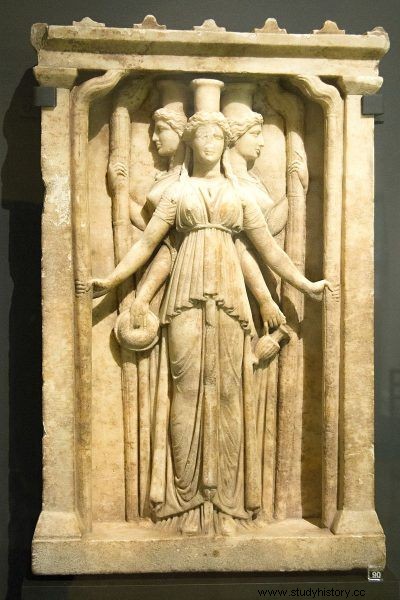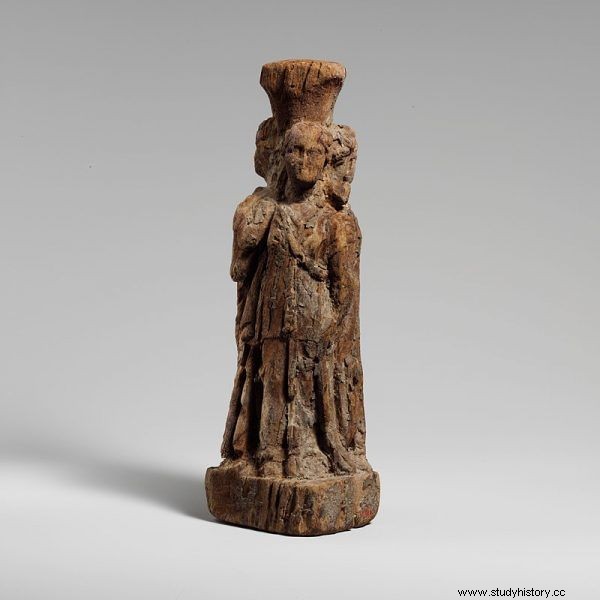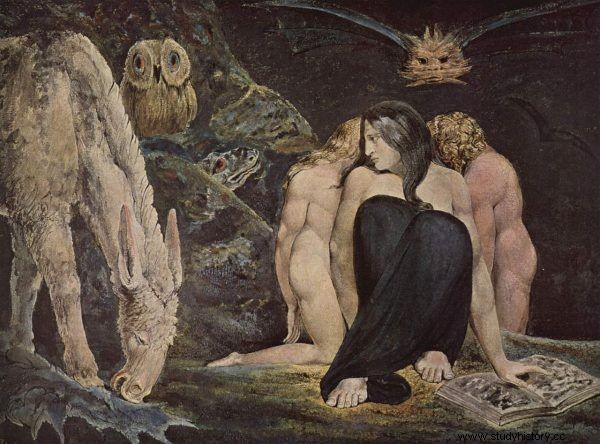She was called a rotting goddess, she guarded the gates of hell and the crossroads. She patronized witches and sent a wild rage on living creatures as she saw fit. Hekate - you don't even realize how little you know about her.
Hecate is one of the oldest and most revered goddesses of the ancient world. Her cult is confirmed as early as the 7th century BCE. and continued uninterrupted until about 400 C.E. And while this goddess is now known as the sinister patroness of witches, it was not like that from the very beginning.
Bright dark beginnings
The cult of Hecate most likely comes from the Little Asian Caria, from where it spread to the West. Originally, she was considered the patron saint of the rich, sailors, herds and the blessings of everyday life . Generally speaking, it was also associated with fertility in this period. It is to her still in the 5th century BCE. Aeschylus advised pregnant women to pray for a light and safe birth.
She had her sanctuary in Lagina, where rituals were held in her honor. In Aegina, annual mysteries were celebrated for her, which, according to legend, were introduced by Orpheus himself. Ritual practices in her honor were associated with the procession of eunuch priests and priestesses, including the "key keepers" in the sacred procession.
All of this changed when the Hellenes entered the stage and combined it with Hades, magic and the dark way.
Triple Goddess
Hecate is an extremely complex deity, and it might seem not entirely tangible in its nature. It appeared in three aspects and at the same time combined them all. As Heaven, she was identified with the goddess Semele, as Earth with Artemis, and in Hades she was associated with Persephone. At the same time, she was also a messenger of the gods, respected by all of them without exception; and also the link between these three worlds.
All this was included in her images created by the ancients. Her most famous depiction comes from the period when the cult of the goddess was established in Athens, around 430 BCE. Alkamenes, a disciple of Phidias, made them. And although the original work has not survived to our times, this sculpture has been copied many times and is now the most famous representation of the goddess Hecate.

Her most famous performance was performed by Alkamenes and it was copied many times
The statue showed three identical women. They face each other and rest against the pillar. The only thing that distinguishes them are the attributes they hold in their hands:torches, a pitcher and a bowl, fruit and a dog accompanying them. Each of these symbols testifies to one of the roles played by the goddess.
Queen of the witches
As I mentioned above, it is to the Hellenes that we owe the dark image of the goddess Hecate. And although it did not have its own myth in itself, we can learn about it from other stories. One of the goddess's attributes was a torch, which was to symbolize her role as a guide. It is in this capacity that she appears in the myth of Demeter and Kora, in which leads her concerned mother to Hades, helping her find her daughter - Persephone, who reigns in the dungeons. After completing the mission, Hecate decided to stay in Hades and keep the queen company.
Hecate inhabited the deepest depths of Hades and surrounded herself with the dead. It was to her as a liaison between the worlds that Aeneas addressed when he descended into Hades in Book VI of the Aeneids.
The goddess was not connected with witches and sorcerers until the 5th century BC. She became their patron during this time, but also the goddess of magic . Roman poet Lucan in the first century C.E. he described her as a demonic figure. He especially pointed to the aspect in which she was associated with Persephone and mentioned that she was worshiped by witches. Thanks to the goddess, they were able to communicate with the dead.
Lady at the crossroads
Due to its nature, Hecate was quickly merged with crossroads. These were mystical, magic-friendly places. She especially loved those places where three roads met, as did its three aspects.
Most probably, wooden poles were originally placed at crossroads, on which three wooden masks were hung, symbolizing the goddess in all its aspects. With time, figurines and statues began to be placed there.

Hekate's performances were also performed in wood
Once a month, most often during the New Moon, Hecate was sacrificed in the form of pies, honey, eggs, fish, onions, lambs or puppies. This was called "Hecate's supper" , and from Aristophanes we learn that this meal was ultimately eaten by the poorest inhabitants, who then convinced everyone that the goddess herself ate the feast. It seems that this custom became a kind of monthly alms and that many beggars were able to live another day thanks to these sacrifices.
The dirt-eating goddess
Hecate also had the role of a cleansing goddess. After the ritual cleansing of households during the holidays, all impurities were collected and burned in front of the house or carried to crossroads. It was extremely important that you throw away the burnt garbage without turning your back.
This role fit perfectly with the putrid, pale-faced goddess. According to some legends, she was so horrible that she had to wear a mask when she went before other gods .
In the magical papyri we find information that other offerings, apart from the monthly feast, were also pleasing to this version of the goddess. To tickle her ego, you could treat her with cow dung incense or a blend of special perfumes made of goat fat, baboon excrement, garlic and other similar flavors .

Despite the terrible image given to her, she was a goddess revered and worshiped for hundreds of years
Sending frenzy and ecstasy
Hecate was also described as the one who, at her discretion, was able to send a painful frenzy on all creatures. Her witches could be filled with ecstasy and madness . But it could reach virtually any mortal.
We also learn from Hippocrates in his treatise on epilepsy originating in the 4th century BCE that it was she was to be responsible for defecating people suffering from epilepsy .
Hecate and all its aspects could be talked about for hours. She was a fascinating goddess who underwent a remarkable evolution from the goddess of fertility and fertility, to the cruel mistress of hell, the guardian of the gates and the patron saint of witches, sorcerers and necromancers. Despite the image she received, she was a goddess who was highly respected not only among gods, but above all among mortals.
Literature:
- P. Grimal, Dictionary of Greek and Roman Mythology , Wrocław 1987.
- Z. Belt, Gods, Demons, Heroes , Mark 1996
- J. Parandowski, Mythology. Beliefs and traditions of the Greeks and Romans, Poznań 1989.
- Y. Rabinovich, The Rotting Goddess , [in:] E. Marx, Junkyard of the Classics, 2006.
